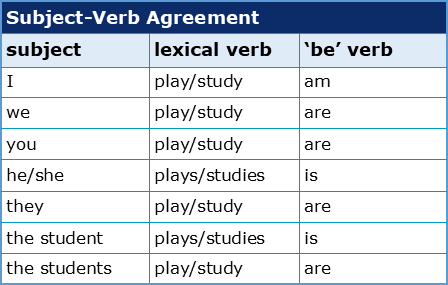What are the seven rules for forming verbs?

This is the fourth of five chapters About Verbs. To complete this reader, read each chapter carefully and then unlock and complete our materials to check your understanding.
– Highlight the fact that additional rules exist on the topic of grammatical verb formation
– Introduce seven rules for correctly forming verbs
– Provide examples and expressions for each rule
Before you begin reading...
-
video and audio texts
-
knowledge checks and quizzes
-
skills practices, tasks and assignments
Chapter 4
Although a number of important rules for correctly determining the forms and functions of verbs have already been discussed in Chapters 1, 2 and 3, this fourth chapter next aims to explore seven additional rules that if followed should greatly help to improve academic success. Each of the seven considerations below are provided with examples and explanations that can be referred back to in the future.
Rule 1: Forming Agreement
As was explained in Chapter 1, verbs are useful to English speakers in that they can demonstrate through suffixation both the person and number of a nominal subject. In other words, whether a subject is first-, second- or third-person (such as ‘I’, ‘you’ or ‘he’) or singular or plural (such as ‘I’ or ‘we’) will have an impact on the correct formation of the verb in question. While students should consider taking our short reader about subject-verb agreement to understand this complex topic in more detail, the most common formations have nevertheless been provided below:

Rule 2: Forming Tenses
Likewise, the addition of the recurring suffixes ‘-s’ and ‘-ed’ to a finite verb can be used to demonstrate present and past tenses in the English language. However, where subject-verb agreement has many additional rules, there is also much variation in how to spell and form verb tenses in the English language. While you may wish to study the subject more carefully in our short reader on tenses, the following two tables should at least demonstrate the most common structures for forming the present and past in the English language:

Rule 3: Forming Aspects
While tense expresses time and is created through morphological inflection, aspect shows duration of time and is demonstrated through the syntactic addition of new words into the verb phrase – such as ‘be’ and ‘have’. In the English language, there are three types of aspect: simple, continuous and perfect. Simple is considered to be the default aspect, and as such is formed simply by following the previous table for creating the present and past tense. To use the continuous or perfect aspects in a piece of writing however, a student must follow the following rules (which are explained in more detail in our short reader on aspect):

Rule 4: Forming the Passive
Another common area of difficulty for students, and one that we’ve also created a specific short reader about, is how to form the passive voice correctly. In opposition to the active voice, the passive voice is used when the speaker or writer wishes to either remove the agent of the action of the verb, or wishes (for whatever reason) to move that agent out of the subject position and into an optional object position using ‘by’. Take, for example, the active and passive voice examples below:


While there may be some additional variation here that students should study and learn, the general construction for forming the passive is as follows:

Rule 5: Forming Yes/No Questions
Students can also run into problems when attempting to create yes or no questions in the English language due to what’s called subject-auxiliary inversion, which is when the auxiliary verb, whether primary or modal, is moved before the subject in interrogative sentences. The following examples show the original declarative statement and then its interrogative version with this inversion applied:

What students should notice in the above example expressions is that when the declarative contains an auxiliary verb, such as ‘will’, ‘can’, ‘have’ or ‘be’, it is this auxiliary verb that’s moved before the subject to create the interrogative statement. However, when there is no auxiliary verb in the declarative, such as with ‘study’ and ‘have’ in the final two examples, then the auxiliary and supporting verb ‘do’ is placed before that subject to create interrogative constructions.
Rule 6: Forming Negatives
The rules for forming negative constructions are similar to the rules for forming yes/no questions in English in that ‘do’ support will sometimes be used. As can be seen in the following table, if an auxiliary verb is found in a declarative statement, then to create the negated statement we simply add ‘not’ after that auxiliary or create a contracted abbreviation of both the auxiliary verb and the negative marker – such as ‘can’t’ or ‘haven’t’. If, however, there is no auxiliary in the declarative, then both the ‘do’ verb and negative marker ‘not’ should be added by the writer or speaker, either as two separate words or in their combined contracted forms:

Rule 7: Forming Short Answers
The final rule that’s important when using verbs is thankfully the simplest to learn. When forming positive short answers to questions such as ‘yes, he will’ or ‘no, she can not’, the easiest thing for a student to do is repeat the auxiliary verb that’s been moved before the subject (inverted) to create the question. Likewise, when creating negative short answers, the same pattern can be followed but with the addition of the negative marker ‘not’:

Downloadbles
Once you’ve completed all five chapters about verbs, you might also wish to download our beginner, intermediate and advanced worksheets to test your progress or print for your students. These professional PDF worksheets can be easily accessed for only a few Academic Marks.
Collect Academic Marks
-
100 Marks for joining
-
25 Marks for daily e-learning
-
100-200 for feedback/testimonials
-
100-500 for referring your colleages/friends